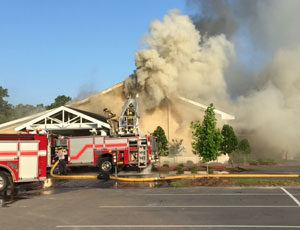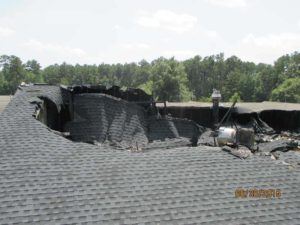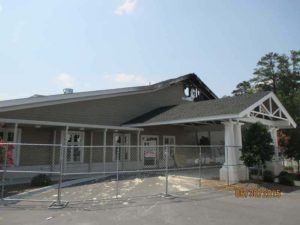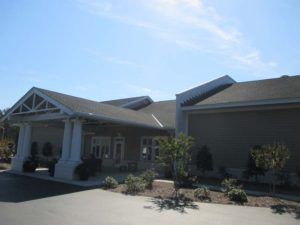When lightning struck The Gibson Cancer Center in Lumberton, a small community in North Carolina, causing a fire and significant damage, there was concern for the patients who received treatment there. Though the fire affected the entire building, destroying a portion of it, the center worked with its insurer, Chubb, to make sure it re-opened as quickly as possible.
On Saturday, June 27, 2015, lightning struck the center and the ensuing fire burned a significant portion of the building to the ground, and caused serious smoke damage to the remaining structure.

Chubb, the building insurer, was notified by the policyholder’s agent that same morning. The Chubb representative on call assigned the loss to a local adjuster who conducted an inspection of the premises the next day.
Due to the magnitude of the damage, the loss was assigned to Michael Koos, a general adjuster with 25 years of experience, 16 of them with Chubb. Koos took the lead in managing the claim and when he arrived on scene he had already mobilized consultants, engineers, equipment specialists and an accounting firm to assist in the damage assessment.

“I was out there the beginning of that week…to assess the damages. Spoke to the insured on Sunday to coordinate things of what would be happening, retain building consultants, engineers that we had, any equipment specialists that we needed to come in and evaluate the medical equipment that they had,” he said.
According to Koos, lightning had struck the roof vent on top of the building and that caused a fire in the attic. A cause and origin investigator inspected the debris and confirmed lightning was to blame.
“We brought in the cause and origin investigator to take a look at it. But once they started going through the debris and they saw the roof vent, it was clearly obvious as to what the cause was, that the roof vent took a direct strike and spread it from there,” explained Koos.
The damage was significant. The medical oncology wing – approximately 13,000 square feet – sustained smoke and water damage. The radiation oncology wing – approximately 5,000 square feet – completed just one year prior was deemed a total loss.

“We were able to determine pretty quickly that the radiation oncology wing, which is a new wing that was…less than a year old, was a total loss,” Koos said. “It needed to be completely knocked down and rebuilt. The medical oncology side had sustained smoke, water, and some soot damage. Equipment was removed from there, cleaned in that area. We were able to salvage that side and do repairs to that side and not have to tear that section down.”
According to Shari Kinlaw, manager of the radiation oncology unit, the center’s staff was able to salvage some pharmaceuticals and patient information in order to set up a temporary location so patients could resume being seen on Monday.
Koos explained that a key component of the radiation oncology department was a piece of equipment called a Versa HD linear accelerator, a new technology that offers pinpoint radiation to cancer patients.
“It was something that they had recently started using. That was in the wing that was damaged by the fire. So, we had the medical equipment company make that their priority on assessing the damage; if it can be saved, cleaned or if it needed to be replaced,” Koos explained.
It was important to identify that particular equipment, what the status was and what needed to be done because the equipment has a five month turnaround time, he said. It was determined very quickly that the machine needed to be replaced.
“If we got the building back up and operating and we didn’t have the machine, they couldn’t see patients,” said Koos.
Luckily, since the fire occurred on a weekend, there were no patient appointments scheduled, according to Kinlaw.
While no one was injured, the fire displaced over 40 cancer patients, Koos said.
“Obviously, our first concern was the patients that were being seen and treated at the facility and what we could do to assist the center with…not being an obstacle to them but helping them assist with relocating patients, continuing their operations as best we could while we’re assessing the damages to see what needs to be done,” Koos said.
The medical oncology department was able to offer treatment on Monday; however, the radiation oncology unit could not deliver radiation, Kinlaw said.
Chubb worked with the center to relocate patients to a temporary medical facility and accelerated the rebuilding of the cancer center, he explained. They were able to set up a temporary location about a half mile away so the center could continue with scheduled appointments.
“We worked with the center and all of the employees early in the week to arrange temporary office facilities so they could continue seeing their patients that were seeking chemotherapy treatments, regular exams, lab,” Koos said. “We helped them set up a facility. It was probably about a half mile away from where the center was at so they could continue their scheduled appointments. Anybody that needed radiation treatments were referred to nearby hospitals. The doctor did have privileges at other places, so they were referred to nearby hospitals so they could continue their treatment.’
Emergency mitigation and repairs were completed by Belfor, and the insurer and its policyholder held weekly status conference calls and meetings during the repair process.
Kinlaw said the meetings were integral for getting repairs completed and the center back up and running.
The estimated time to complete repairs was 13 months, said Koos. Chubb, recognizing the needs of the patients, center and community, arranged and paid additional fees to the contractor to arrange an expedited repair schedule.
The repairs and partial rebuild were completed within nine months, Koos said.
“We were able to complete the repairs in nine months, so it was four months ahead of schedule,” Koos said. “They were able to open the facility…on March 21st.”

As a result, the facility was fully operational with new and improved equipment, he said.
Kinlaw said that the whole process was a real team effort.
While Koos had considerable claims handling experience prior to this claim, he said the loss was a valuable learning experience for him.
“In my career, this was probably the claim that I have gained what I would say is…the most hands on experience and knowledge in handling it. There were so many facets to this claim. It wasn’t just we’re dealing with building damage and let’s concentrate on that. There was everything that was involved with this – from building damage to contents damage, medical equipment, the patients and the patients’ care along with the business interruption portion of the claim,” Koos said. “Lumberton is a very small community. This cancer center meant so much to this community that it was devastating when it was destroyed. It was a heartwarming feeling handling this claim as it progressed and to see the direction it was going.”
Was this article valuable?
Here are more articles you may enjoy.

 DraftKings Sued Over ‘Risk-Free’ Bets That Were Anything But
DraftKings Sued Over ‘Risk-Free’ Bets That Were Anything But  Report Using Aerial Imagery Keys in on Hailstorm Risks to Colorado Homes
Report Using Aerial Imagery Keys in on Hailstorm Risks to Colorado Homes  Poll: Consumers OK with AI in P/C Insurance, but Not So Much for Claims and Underwriting
Poll: Consumers OK with AI in P/C Insurance, but Not So Much for Claims and Underwriting  Hawaiian Electric Hits 40-Year Low Ahead of Maui Fire Report
Hawaiian Electric Hits 40-Year Low Ahead of Maui Fire Report 